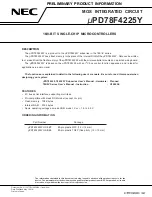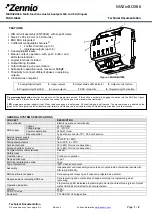GD32F10x User Manual
68
Generally, digital circuits are powered by V
DD
, while most of analog circuits are powered by
V
DDA
. To improve the ADC and DAC conversion accuracy, the independent power supply
V
DDA
is implemented to achieve better performance of analog circuits. V
DDA
can be externally
connected to V
DD
through the external filtering circuit that avoids noise on V
DDA
, and V
SSA
should be connected to V
SS
through the specific circuit independently. Otherwise, if V
DDA
is
different from V
DD
, V
DDA
must always be higher, but the voltage difference should not exceed
0.3V.
To ensure a high accuracy on ADC and DAC, the ADC/DAC independent external reference
voltage should be connected to V
REF+
/V
REF-
pins. According to the different packages, V
REF+
pin can be connected to V
DDA
pin, or external reference voltage which refers to
, V
REF-
pin must be connected to VSSA
pin. The V
REF+
pin is only available on no less than 100-pin packages,
or else the V
REF+
pin is
not available and internally connected to V
DDA.
The V
REF-
pin is only available on no less than
100-pin packages, or else the V
REF-
pin is not available and internally connected to V
SSA
.
3.3.3.
1.2V power domain
1.2V power domain supplies power for Cortex
®
-M3 logic, AHB / APB peripherals, the APB
interfaces for the Backup domain and the
V
DD
/ V
DDA
domain, etc. Once the 1.2V is powered
up, the POR will generate a reset sequence on the 1.2V power domain. If need to enter the
expected power saving mode, the associated control bits must be configured. Then, once a
WFI
(Wait for Interrupt)
or WFE
(Wait for Event)
instruction is executed, the device will enter
an expected power saving mode which will be discussed in the following section.
3.3.4.
Power saving modes
After a system reset or a power reset, the GD32F10x MCU operates at full function and all
power domains are active. Users can achieve lower power consumption through slowing
down the system clocks (HCLK, PCLK1, PCLK2) or gating the clocks of the unused
peripherals. Besides, three power saving modes are provided to achieve even lower power
consumption, they are Sleep mode, Deep-sleep mode, and Standby mode.
Sleep mode
The Sleep mode is corresponding to the SLEEPING mode of the Cortex
®
-M3. In Sleep mode,
only clock of Cortex
®
-M3 is off. To enter the Sleep mode, it is only necessary to clear the
SLEEPDEEP bit in the Cortex
®
-M3 System Control Register, and execute a WFI or WFE
instruction. If the Sleep mode is entered by executing a WFI instruction, any interrupt can
wake up the system. If it is entered by executing a WFE instruction, any wakeup event can
wake up the system (If SEVONPEND is 1,
any interrupt can wake up the system, refer to
Cortex-M3 Technical Reference Manual). The mode offers the lowest wakeup time as no time
is wasted in interrupt entry or exit.
According to the SLEEPONEXIT bit in the Cortex
®
-M3 System Control Register, there are
Summary of Contents for GD32F10 Series
Page 63: ...GD32F10x User Manual 63 programmed during the chip production ...
Page 117: ...GD32F10x User Manual 117 010 1 0 011 0 9 ...
Page 416: ...GD32F10x User Manual 416 shadow register updates every update event ...
Page 427: ...GD32F10x User Manual 427 value ...
Page 518: ...GD32F10x User Manual 518 These bits are not used in SPI mode ...


















